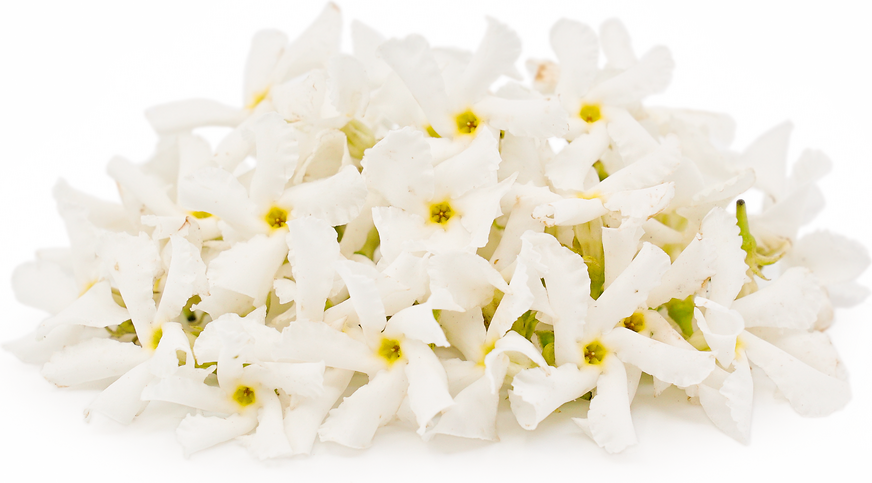


Jasmine MicroFlowers™
Estimated Inventory, 4 oz : 2.00
This item was last sold on : 07/09/25
| Fresh Origins | Homepage |
Description/Taste
Jasmine flowers are small blooms, averaging 1 to 3 centimeters in diameter, and are comprised of five petals arranged around a tiny yellow center, attached to a short green stem. Each petal is long, narrow, oval, and slightly curled with faintly ruffled edges. The petals are also white and bear a soft, delicate, subtly waxy, and velvety consistency. Jasmine flowers emit a fragrant, rich, and sweet floral aroma. When the petals are lightly bruised, they may also give off a slightly grassy scent. Jasmine flowers are edible, but they have a mildly sweet, perfumed flavor mixed with a sometimes unpalatable, bitter taste.
Seasons/Availability
Jasmine flowers are available year-round through Fresh Origins.
Current Facts
Jasmine flowers are botanically a part of the Oleaceae family, and there are over 200 species of Jasmine flowers found worldwide. Despite the flower’s diversity, there are only a few types that are considered edible and safe for culinary use, mainly coming from the Jasminum sambac species. It is important to note that some Jasmine flowers can be toxic, and discretion and research should be conducted before consuming flowers from the wild. Fresh Origins Farm in San Diego, California, produces food-safe Jasmine flowers. The delicate white blooms are edible, but the flower’s bitter nature is generally unpleasant. Most chefs use the flowers as a garnish or as a flavoring ingredient in sweet and savory preparations. Jasmine flowers can impart a floral, sweet, and aromatic taste into culinary dishes and mixology, and the blooms are highly favored for their pleasant aroma and romantic, ornamental appearance.
Nutritional Value
Jasmine flowers have not been extensively studied for their vitamin and mineral content, but the blooms have been utilized in natural medicines to reduce stress. The essential oils found within the flowers are believed to provide relaxing properties, and the blooms contain linalool, a natural terpene used to calm the body and mind. Jasmine flowers have also been infused into skincare and lotions for topical use or infused into teas to soothe and cleanse the digestive tract.
Applications
Jasmine flowers are edible, but the blooms generally contain a bitter aftertaste, creating a somewhat unfavorable experience. Chefs primarily utilize the blossoms as an infusion ingredient or food-safe garnish, favored for their signature fragrance. Jasmine flowers can be used whole on top of cakes and tarts, frozen into ice cubes, or the petals can be sparingly sprinkled over green salads. The flowers can also be incorporated into dressings, used to flavor cocktails, cooked into syrups, or infused into water. In Thailand, Jasmine-infused water is known as Nam Loy Dok Mali and is a favorite beverage served on Mother’s Day. The flowers symbolize purity and love and are the main flower used to honor mothers in Thailand on the annual holiday. Jasmine flower syrup can also be mixed into fruit salads, used as a flavoring in custards, cheesecake, cookies, macaroons, and mooncakes, infused into ice cream, or added to poached pears. In addition to sweet preparations, Jasmine flowers complement shellfish, cold noodle dishes, chicken broth soups including pho, rice, or served with dim sum. Jasmine flowers pair well with herbs such as spearmint, cilantro, and basil, fruits including pomegranate, strawberries, mango, lemon, watermelon, coconut, and blueberries, white chocolate, and leafy greens such as endive, arugula, and spinach. Whole Jasmine flowers will keep 4 to 5 days when stored in the refrigerator. When purchased from Fresh Origins, the flowers can be kept in their original clamshell.
Ethnic/Cultural Info
Jasmine flowers are most famously used to flavor tea. The fragrant blossoms contribute a refreshing, floral scent, and the practice of combining the flower’s aroma with grassy, herbal tea dates back over 1000 years. Experts hypothesize Jasmine flowers were brought to China during the Han Dynasty and were first infused into tea in Fuzhou, a city in the Fujian province. Jasmine flower buds are traditionally harvested in the early afternoon, and the buds are mixed with the tea leaves in a scenting house. When the buds open in the evening, the tea leaves absorb the flower’s intoxicating aroma and retain the light flavoring even when steeped in hot water, creating the celebrated beverage. Jasmine tea was initially spread across Asia through trade routes, and by the early 20th century, the scented tea became favored across Asia. There are several different grades of Jasmine tea sold throughout China, depending on the scenting process and how many times the tea leaves were exposed to the flower’s aroma. Jasmine tea can also be found in green, black, white, and oolong types, with green tea being the most popular. Fuzhou Jasmine tea is considered the most well-known type of Jasmine tea worldwide and is consumed as an afternoon beverage or palate cleanser alongside meals.
Geography/History
Jasmine flowers are believed to be native to the region of land, which is now modern-day Iran, and have been cultivated since ancient times. The flowers were introduced to China sometime before 220 CE, and the blooms were quickly spread across Asia, valued for their fragrance, ornamental nature, and oils. Over time, many different varieties of Jasmine flowers were developed and grown worldwide, and the aromatic blooms have become cultural symbols of love, purity, innocence, and positivity. The Jasmine flowers featured in the photograph above were sourced from Fresh Origins Farm in San Diego, California. Fresh Origins has been using the mild Southern California climate to produce healthy, natural, and beautiful Jasmine flowers for culinary use. Fresh Origins also has the highest level third-party-audited food safety program and is a certified member of the California Leafy Greens Marketing Agreement, which follows science-based food safety practices to promote transparency and honesty in production. Today Jasmine flowers grown by Fresh Origins can be found through select distribution partners across the United States, including Specialty Produce, and are also found through partners in Canada.
Featured Restaurants
Restaurants currently purchasing this product as an ingredient for their menu.
| Camino Riviera Bar | San Diego CA | 619-685-3881 |
| Little Fox Cups + Cones | Oceanside CA | 978-994-1745 |
Recipe Ideas
Recipes that include Jasmine MicroFlowers™. One
| Cooking With Nart |
|
Jasmine-Infused Water |




 Learn More...
Learn More...
